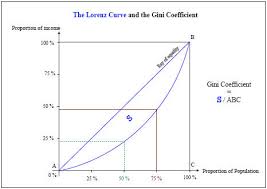Lorenz Curve and Gini Coefficient – measuring equality and egalitarianism in society
Lorenz Curve was given by a famous American economist Max Lorenz in 1905. It graphs the perfect equality of wealth which is represented by a straight diagonal line. The Lorenz curve lies beneath it, showing what actually is the reality of wealth distribution. The amount of inequality of wealth distribution is shown by the difference between the straight line and the curved line it is called the “Gini Coefficient”. The coefficient is zero in a perfect egalitarian society and is 1 for the economy in which the wealthiest held all the wealth. Gini coefficient for US is 0.4%, Sweden -0.25%, Bolivia-0.61%.
Talking about the Gini Coefficient for India, the gap between the poor and rich is widening. Gini coefficient between 1990’s -2000’s increased from 30.8% to 33.9%. In India factors responsible for this widening gap are : Poor quality of Education ( In India the average population of out-of-school primary school-age children was 20% in 1993-2003, we have weaker labour laws, our policies and laws encourages fragmentation rather than integration and since China has understood this flaw they have already started working upon this but India still remains far behind from China.
It is also surprising that neighbouring countries of India like Bangladesh, Nepal and Pakistan all have lower Gini Coefficient than us. Manufacturing sector of India has declined from 37% in 1990 to 22% in mid 2007 because the gains in productivity was not passed on to wages. India is showing a Jobless Growth since wage employment elasticity of India fell from 0.44 in 1991-2001 to 0.28 in 2001-2011 ( Source : Asian Development Outlook, April 2012, Asian Development Bank).
The solutions to narrow these widening gaps are:
1) To increase the public investments in the sector of health and education.
2) Provision of basic amenities to rural poor and urban slums.
3) Secure the rights of labour
4) More spending on Social protection Scheme.
Narrowing the inequality gap is an important task to improve the economic condition of the economy.





22 Comments. Leave new
Informative 🙂
Very well explained!!
Well written!
nice explanation
Well explained!
Informative aarticle! :-)great efforts
nice
Useful info.
Informative article
Good one!
New information. Thanks!
Informative
Very well explained!
Got something new to read 😀
GOod work 😀
informative
Very well explained
you’ve explained it very well!
Good work!
nice
Nicely Explained. Good! 🙂
nice
Great article!